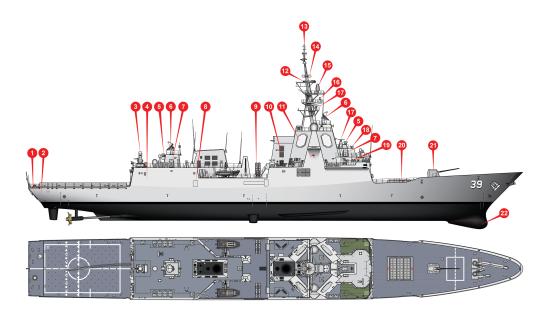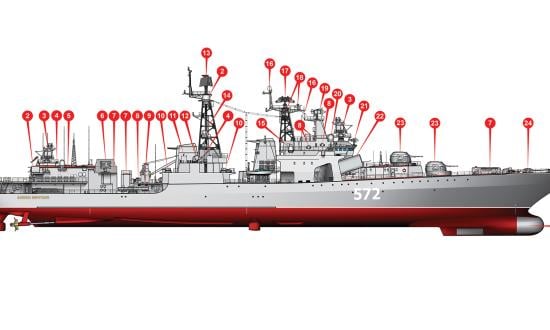Germany’s Baden-Württemberg-class frigates were conceived during the late 1990s and early 2000s and ordered in June 2007. The four-ship class reflects an early 21st-century/post-9/11 emphasis on unconventional naval missions such as conflict prevention, crisis management and intervention, and stabilization operations. The ships carry nonlethal weapons including water cannon, incapacitating lights, and sonic weapons, and they have been criticized for lacking the hull-mounted sonar, layered air-defense, and vertical-launch systems typically found in modern, multirole surface combatants.
The ships do carry conventional naval weapons, however, including two quadruple launchers for Harpoon anti-ship missiles, two 21-round Mk-49 Rolling Airframe Missile (RAM) point-defense surface-to-air missile (SAM) systems, and a single 5-inch/127-mm naval gun. Remotely operated 27-mm and 12.7-mm machine guns are fitted for in several places self defense. A flight deck and twin hangars are located aft for two NH-90 Sea Lion or Mk-88A Super Lynx submarine-hunting naval helicopters.
The Baden-Württemberg frigates are designed to operate at sea for 5,000 hours per year, deployed for up to two years at a time. The ships achieve this through multiple crews, sea swaps, and innovative reliability and maintainability efforts. Crew size is only 120, a dramatic reduction compared with previous generations of warships, achieved largely through automation. Extra space is available for a 50-person special forces contingent when needed, along with four rigid-hull inflatable boats (RHIBs) in covered bays on either side of the hull. There also is room to expand the standard aviation detachment by 20 additional personnel to assist with extended deployments and operations.
The 490-foot frigate has a beam of 62 feet and a draft of roughly 18 feet. Propulsion is provided by combined diesel-electric and gas (CODLAG), with four diesel generators and one gas turbine allowing top speeds in excess of 26 knots and a cruising range of 4,000 nautical miles at 18 knots.
Displacing some 7,000 tons, these warships are among the largest operational frigates in the world and the largest German surface combatants since World War II. They incorporate numerous radar, acoustic, and infrared signature-reduction measures. A heavy emphasis on survivability has resulted in numerous safety enhancements and system redundancies, including twin island structures.
The Baden-Württemberg, pictured, was initially delivered in 2016 but subsequently returned to the shipyard after significant weight and stability problems were discovered during sea trials. She was not commissioned until June 2019. The Nordrhein-Westfalen joined the fleet in June 2020. The remaining two, the Sachsen-Anhalt and Rheinland-Pfalz, are expected to enter service during the next few years.
| 1. Helicopter handling and traverse system |
| 2. Hitrole-NT 12.7-mm remotely operated machine gun |
| 3. Hangar for two NH-90 Sea Lion or Mk-88A Super Lynx helicopters |
| 4. 21-tube Mk-49 launcher RIM-116 SeaRAM SAMs |
| 5. X-band navigational radar |
| 6. S-band navigational radar |
| 7. MSSR 2000 I identification-friend-or-foe (IFF) |
| 8. MSP-600 electro-optronic tracking system |
| 9. SIMONE infrared search-and-track (IRST) system |
| 10. MASS decoy launchers |
| 11. TRS-4D 4-panel active electronically scanned array (AESA) radar |
| 12. Nonlethal light/sonic weapon system |
| 13. Quadruple RGM-84 Harpoon ASCM launcher canisters |
| 14. Covered bay for 10.1- or 11-meter RHIBs |
| 15. 20-foot modular equipment container |
| 16. 27-mm MLG-27 remotely operated naval gun |
| 17. KORA 18 radar communication electronic support measures (RCESM) system |
| 18. 127-mm/64-cal multipurpose gun |







